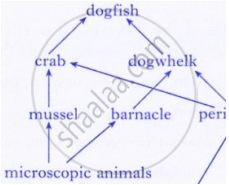Advertisements
Advertisements
प्रश्न
What is meant by a primary consumer, secondary consumer and a tertiary consumer? Give one example of each.
उत्तर
Herbivores that feed on plants are called primary consumers. Example: Insects.
Small carnivores that feed on other animals, especially herbivores, are called secondary consumers. Example: Frogs.
Large carnivores that feed on other animals, especially secondary consumers, are called tertiary consumers. Example: Birds.
Insects → Frogs → Birds
(Primary consumers) (Secondary consumers) (Tertiary consumers)
APPEARS IN
संबंधित प्रश्न
What are the various steps of food chain called?
Give two differences between food chain and food web.
What will happen if deer is missing in the food chain given below?
Grass → Deer → Tiger
The ten per cent law is associated with
(a) transfer of energy from various trophic levels to decomposers in a food chain
(b) transfer of ATP energy into muscular energy
(c) transfer of chemical energy from one organism to another
(d) transfer of sun's energy to the organisms called producers.
A food chain consists of fish, larvae, phytoplanktons and birds. The level of pesticides in water in which the fish, larvae and phytoplanktons live is quite high.
Which organism will have the maximum amount of pesticides accumulated through the food chain? What is this process known as?
Primary consumers that eat plants are called _______.
Which of the following is a logical sequence of food chain?
Which of the following is an autotroph?
Observe the food web and answer the questions given below:

Why do all food chains start with plants?
In the following food chain, only 2J of energy was available to the peacocks. How much energy would have been present in Grass? Justify your answer.
GRASS → GRASS HOPPER → FROG → SNAKE → PEACOCK
